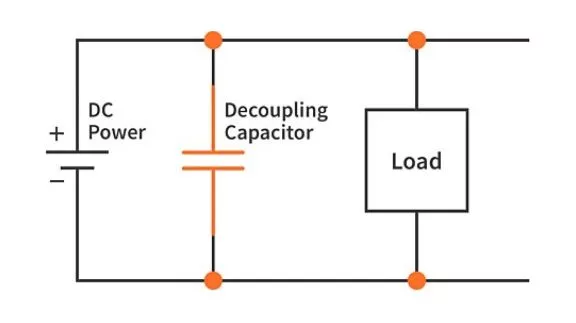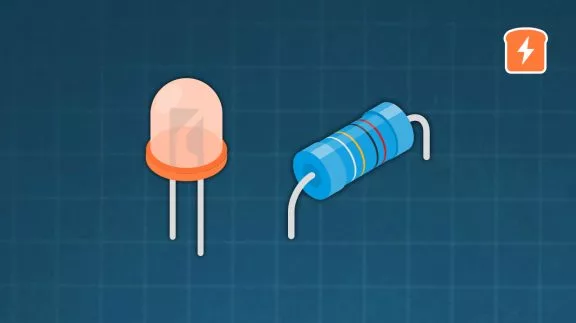Parallel and Series Resistors
Published
One would think that, if you need a specific resistance, you would find a resistor of that resistance and you’d never have to worry about putting multiple resistors together. The reality is that putting resistors in parallel or series is extremely common, whether on purpose or as a side effect. From basic voltage dividers to banks of LEDs in parallel, you’ll find resistors in combination nearly everywhere.
Resistors in Series
When resistors are in series, it means that one resistor directly follows another. Of the two nodes of a resistor, one of those nodes is connected to a single node of another resistor, and nothing else. An image will help illustrate this case.

You can see that if any electricity flows through one of the resistors, it has nowhere else to flow but through the other resistor. When two resistors are put in series, you always get the same current through both of them. So, you can consider that the equivalent resistance of two resistors in series is the sum of the separate resistances.
And unless the resistance is the exact same, however, you will have different voltages over them. Let’s do a sample to show why that is.

With the two resistors in series, we get an equivalent resistance of 500 ohms - a simple summation of the two resistances. Using Ohm’s Law, we can discover the current flowing through *both* resistors. With 5V over 500 ohms, we get .01 amps, or 10 milliamps.

But then, to discover the voltage over each resistor, we use Ohm’s Law again, but looking for voltage versus amperage. So, we multiply the current and the resistance. For the 100 ohm resistor, we multiply .01 by 100 ohms, giving us 1V. That means that in this setup, the 100 ohm resistor has 1V across it. For the 400 ohm resistor, we multiple .01 by 400 ohms, giving us 4V.

And, if you had 1V and 4V, you get 5V, giving us the warm and fuzzy that we did our math right.
So, again, resistors in series have the same current running through them and, unless they have the same resistance, different voltages. And note that resistors in series always produce a higher equivalent resistance.
Resistors in Parallel
When resistors are in parallel, it means that the resistors “split” the current. Of the two nodes of a resistor, both of those nodes are connected to both nodes of another resistor. Of course, for this to make any sense, those nodes also *must* be connected to something else - even if it’s just power and ground. An image will help illustrate what the simplest resistors in parallel case looks like.

Since both nodes are connected, you can see that the voltage across these resistors will always be the same. However, as they’re in parallel, unless they have the exact same resistance, they will have different currents through them. To find the equivalent resistance of these two in parallel, it would be possible to individually calculate the current through the resistors, add that current together, and then use Ohm’s Law to calculate for resistance, now that you know the voltage and the overall current. However, there are much easier ways to do it, though it will never be as simple as it is with resistors in series.
How to Find the Parallel Equivalent Resistance
Finding the parallel equivalent resistance is not that complicated, yet it still manages to throw me off because I still manage to forget the final inversion. In words, you find the parallel equivalence by getting the inverse of the sum of the inverses. This may sound crazy at first, but look at the equation:

As you can see, the equivalence is the summation of the inverses of the resistances. And then, once that sum has been found, you invert that as well.

Perhaps a common mistake, or perhaps just something I struggled with at first, is remembering to invert that final number. An easy way to do a sanity check on this is that, if you did it right, the overall resistance will be lower than the lowest, or smallest, resistance of the resistors included.
Let’s do a sample using the same values we used with the series resistors.

With this, we add 1/100 + 1/400 and get 1/80. Getting the inverse of that gives us 80 ohms. So, the equivalent resistance is 80 ohms. It’s smaller than the smallest resistance, so we can feel good that we’re at least not too far off. If we want, we can verify by calculating the total current that goes through the combination of the resistors as well as the resistors individually.

However, if you have only two resistors, you can use a simplified equation to solve for the equivalent resistance. And if the two resistors are the same value, then it’s even simpler - divide the resistance in half! Otherwise, you can use the following equation:

You can put as many resistors in parallel and series as you want, there’s nothing stopping you, though it does get ridiculous after a point.
And as a bonus, all of this applies perfectly to inductors in parallel and series. But *not* to capacitors!
That’s it! If something is not clear, post it in the comments below and we’ll either respond there or update this tutorial as necessary.
In Summary:
- Resistors in series are simply summed together.
- Resistors in parallel are a little more complicated, but still straightforward. It’s probably best to memorize the equations.
- Resistors in series always produce a higher equivalent resistance.
- Resistors in parallel always produce an equivalent resistance less than the smallest resistor.
Exercise
If someone gives me a circuit how would I be able to tell if the resistors are in series or parallel?
There are two things to remember when checking if resistors are in series or parallel. The first thing to remember is that it's extremely common that the resistors are not in series or parallel, but that their relationship is more complicated and the simple tools to find equivalent resistance won't actually work.
However, the easiest way to figure out if they are in series or parallel and to see which one it is, is look at the two nodes, or the two ends of each resistor. If the resistors have one node in common and nothing else attached to that node, then they're in series. If the resistors have both nodes in common, even with something else connected to those nodes, then they're in parallel. If you look at the thumbnail for this video, you can see that the image on the left, the parallel configuration, has both ends (or both nodes) of both resistors connected to each other. On the right image, the series configuration, it only has one end (or one node) of each resistor connected together.
Check Yourself
10 Questions
Tutorial FAQs
If someone gives me a circuit how would I be able to tell if the resistors are in parallel or series?
There are two things to remember when checking if resistors are in parallel or series. The first thing to remember is that it's extremely common that the resistors are not in series or parallel, but that their relationship is more complicated and the simple tools to find equivalent resistance won't actually work.
However, the easiest way to figure out if they are in series or parallel and to see which one it is, is look at the two nodes, or the two ends of each resistor. If the resistors have one node in common and nothing else attached to that node, then they're in series. If the resistors have both nodes in common, even with something else connected to those nodes, then they're in parallel. If you look at the thumbnail for this video, you can see that the image on the left, the parallel configuration, has both ends (or both nodes) of both resistors connected to each other. On the right image, the series configuration, it only has one end (or one node) of each resistor connected together.

Get the latest tools and tutorials, fresh from the toaster.













